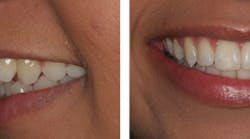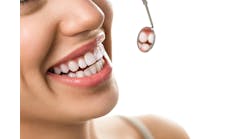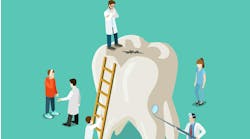by Stephen Ball, BDS
There has been a major movement in dentistry to preserve as much tooth structure as possible. General dentists are moving away from the veneer boom of the 2000s, and have moved into tooth alignment as the cosmetic treatment of choice.
One of the main driving forces behind this move has been a change in philosophy that means dentists are now seeking to provide quality cosmetic solutions that are also minimally invasive and preserve as much tooth structure as possible. Another key factor has been the growing demand from adult patients who are seeking quicker fixes to their teeth, don't want to go down the traditional restorative route, and are not willing to accept comprehensive orthodontics.
Short-term orthodontics (STO) is a cosmetic solution for your adult patients, and is a great service and revenue stream that can be added to dental practices. It is easy, effective, and many patients want it. As with any treatment, case selection is paramount in deciding who to treat. It is a useful alternative to traditional treatment options, such as crowns and veneers. It is not only less destructive, but is also more cost-effective. This means that more patients can access this treatment and can achieve fantastic smiles in the space of only six months.
Case presentation
The patient is a 24-year-old schoolteacher. She came to us interested in veneers. She thought that this would be the best way to improve the appearance of her teeth. After an initial consultation, it soon became apparent that placing veneers would be a destructive option since much preparation would be needed to achieve an ideal cosmetic result.
After we explained the various pros and cons of veneers, the patient asked if there were any other options. Naturally, we then explained that one option is comprehensive orthodontics that would involve 12 to 18 months. We also then described a more cosmetically focused approach, in the form of Six Month Smiles, that would straighten her teeth in about six months.
Having discussed the various merits and drawbacks of each option, the patient opted for Six Month Smiles as the relatively short treatment time was appealing to her, and she wanted to preserve as much of her natural tooth structure as possible. She only wanted a cosmetic fix, not a functional correction that comprehensive orthodontics would have provided.
After completing the standard consent procedure, we then took a full set of impressions as per the usual protocol, and sent these off to the Six Month Smiles laboratory. A few days later, we received the patient's individualized Patient Tray Kit that included her custom indirect bonding trays.
These trays make accurate placement of the clear brackets a simple and straightforward process. We then followed the normal protocol for placing the clear brackets using the trays and tying in the tooth-colored wires in the normal fashion.
This case is an excellent example of the "ideal case" for short-term orthodontics. The patient's molar and canine relationships were class 1 on both sides with a normal tooth width ratio, upper-to-lower. We were not planning any anterior-posterior relationship changes so this case was perfectly suited for a GP to complete.
After five months, the orthodontic part of the treatment was completed and the clear brackets were removed. We then finished the case with tooth whitening to further improve the appearance of the patient's teeth. I have found that short-term orthodontics on adults can also lead to additional cosmetic work, such as whitening or composite bonding, to really finish the smile.
At the end of treatment, the patient was delighted with the results, and has become a great advocate for our practice. She has even recommended many friends to come and see us as a result of the treatment. It's satisfying to see how much difference this simple, yet effective, short-term orthodontic system can have.
Stephen D. Ball, BDS, is a general dental practitioner in private practice in Rotherham, UK. He has a special interest in many types of adult short-term orthodontic treatment, and is a mentor on the Six Month Smiles clinical team.
Past DE Issues







